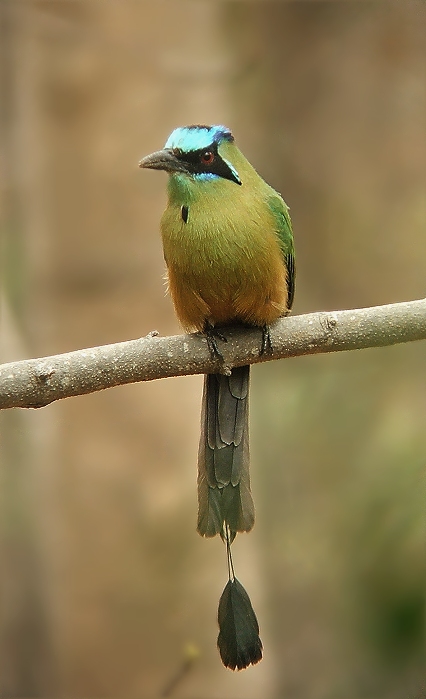Alternative name: Blue-diademed Motmot
- Momotus momota
Identification
38-48 cm. Green upperparts (olive in subspecies osgoodi), green or rufous underparts depending on subspecies (very variable how dark), black central spot on upper breast, black central crown surrounded by blue band (or crown entirely blue in subspecies coeruliceps), black eyemask sometimes edged pale at the back. Tail is green with blue lower tail with two longest feathers showing an area missing barbs followed by an area with barbs (rackets); the tip of these feathers is black in some subspecies.
Notice that the tail feathers are normal when growing, the barbs fall off shortly after, and it is therefore possible to see a bird of this species that is missing rackets (feathers may also break below the rackets).
Juvenile has reduced black on upper breast.
Distribution
Mexico to northern half of South America.
Taxonomy
Twenty subspecies are known for Blue-crowned Motmot. A recent paper[2] proposes that these should be split into several species, here treated as groups:
- group coeruliceps from north-eastern Mexico is the only with blue crown; this is a monotypic form. Not included in the study mentioned.
- group lessoni from southern Mexico to western Panama. Includes subspecies goldmani, exiguus, and lessoni.
- group subrufescens from central Panama to north-central Venezuela, with parts of Colombia, in subspecies subrufescens, osgoodi, and spatha, and isolated from the rest in south-east Ecuador and south-west Peru is subspecies argenticinctus (subspecies conexus, reconditus, and olivaresi no longer recognized).
- group bahamensis from Trinidad and Tobago is monotypic
- group momota from the Amazon bassin includes microstephanus, momota, ignobilis, marcgravianus, nattereri, simplex, pilcomajensis, cametensis, and paraensis.
Notice there are differences between these groups and those listed in the Clements spreadsheet[3].
Highland Motmot has in the past been considered a part of Blue-crowned Motmot.
Habitat
Habits near water, rivers, streams, and builds its nest in hollows excavated on banks. Likes to perch on branches in the shadow, inside forest.
Behaviour
It nests in tunnels in a bank, 3-4 white eggs are laid.
The diet includes insects, lizards and fruit.
Most subspecies has a song consisting of two hoots, but the song is a single "whoop" in those belonging to group subrufescens.
References
- Clements, James F. 2007. The Clements Checklist of Birds of the World. 6th ed., with updates to October 2007. Ithaca: Cornell University Press. ISBN 9780801445019
- F. Gary Stiles 2009. A REVIEW OF THE GENUS MOMOTUS (CORACIIFORMES: MOMOTIDAE) IN NORTHERN SOUTH AMERICA AND ADJACENT AREAS. Ornitología Colombiana No.8 (2009): 29-75. Subject of Birdforum discussion here
- Clements, JF. 2008. The Clements Checklist of Birds of the World. 6th ed., with updates to December 2008. Ithaca: Cornell Univ. Press. ISBN 978-0801445019.
Recommended Citation
- BirdForum Opus contributors. (2024) Blue-crowned Motmot. In: BirdForum, the forum for wild birds and birding. Retrieved 4 May 2024 from https://www.birdforum.net/opus/Blue-crowned_Motmot





